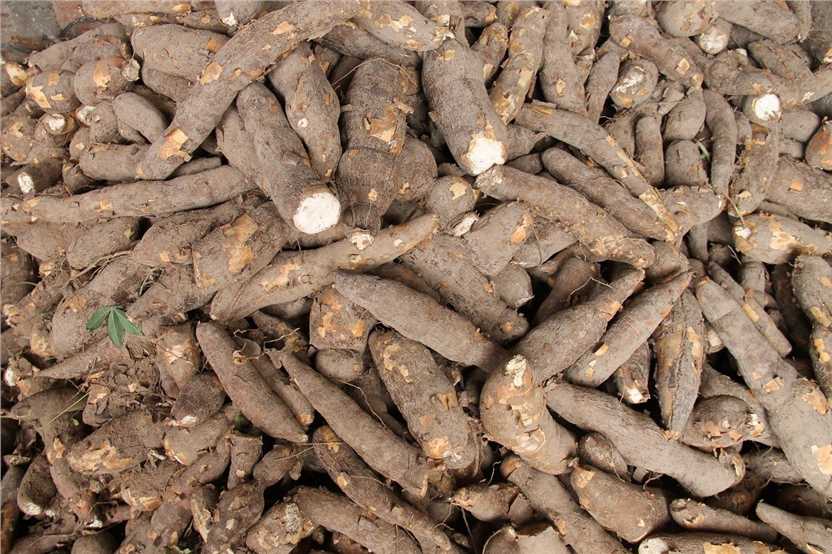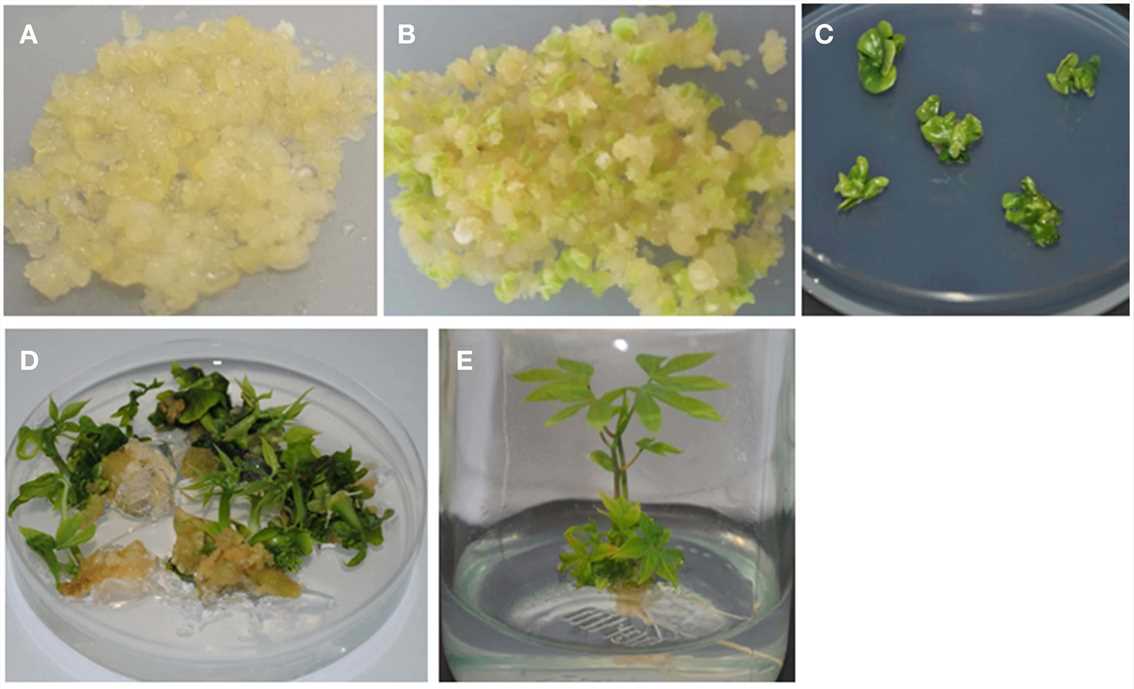Manihot esculenta Crantz, also known as cassava, it is a plant of the cassava genus Euphorbiaceae. Manihot esculenta Crantz is widely planted in more than 100 countries and regions in Africa, America and Asia. It is one of the three major potato crops and the sixth largest food crop in the world. Therefore, it is also called "king of starch". Cassava has excellent characteristics such as easy growth, easy cultivation, high yield and can be harvested in four seasons. In addition to being used as food, cassava is also widely used in the production of feed, starch and industrial raw materials such as fuel ethanol. In order to further improve the nutritional value and industrial value and reduce the cost of cultivation process of cassava, research on genetically modified Manihot esculenta Crantz has become a hot field in recent years. Most genetic modifications have been done aiming to improve Manihot esculenta Crantz's disease resistance, insect resistance, herbicide resistance, salt tolerance, cold tolerance, storage tolerance, tuber quality, etc.

Lifeasible provides one-stop services, covering all steps including experimental design, vector construction, plasmid transformation, positive transplant screening and characterization of transgenic Manihot esculenta Crantz. We offer Manihot esculenta Crantz transformation using various genetic engineering technologies as follows:
Gene overexpression is a common technique for studying gene function. The development and utilization of gene overexpression has brought us many conveniences for studying gene function and improving the yield of target products. Through the quantitative overexpression of genes related to starch, amino acid, fat and other chemical components in Manihot esculenta Crantz, the production of specific compounds can be increased. We could help you overexpress many genes including gene HNL that regulates the cyanide content of cassava, gene G336D that affects the starch content of cassava tubers, genes APX, ZnSOD which affect the cold tolerance of cassava, the sucrose sugar glycosyltransferase gene 1-SST that improves the positive resistance of transgenes, gene MeGalt1 related to the physiological decay of cassava tubers, and many other genes related to important traits of Manihot esculenta Crantz.
RNAi is a technology widely used for specific gene silencing, which is mediated by double-stranded RNA (dsRNA) and involved in specific enzymes. It blocks gene expression at the transcription level and translation level. For example, through RNAi technologies, we can inhibit the expression of related genes in Manihot esculenta Crantz by forming a hairpin structure. Thus, the resistant Manihot esculenta Crantz which is completely resistant to the cassava brown streak Uganda virus (CBSUV) is obtained.
Virus induced gene silencing (VIGS) is a genetic technology that inhibits the expression of endogenous genes in plants by inserting recombinant viruses into target gene segments, they can induce plant endogenous gene silencing and cause phenotypic changes, and then study the function of target genes based on phenotypic changes. The VIGS technology is a method of transient transformation and underlying molecular basis may be post-transcriptional gene silencing. Silencing and functional analysis of target genes in Manihot esculenta Crantz through VIGS can help our customers save time and achieve valuable information for gene functional analysis. With wealth of experience in VIGS, our scientists in Lifeasible can provide you with customized protocol for VIGS in Manihot esculenta Crantz.
CRISPR gene knockout technology is currently the most widely used gene knockout technology, it provides us with a very powerful and convenient gene editing tool. As a leading company that has been deeply involved in the field of gene editing for many years, through CRISPR technology, we can knockout Manihot esculenta Crantz's genes in different ways, including frameshift mutations, multiple deletion of fragments, knockout of non-coding genes, knockout of multiple copies of genes, etc.
CRISPR system has strong scalability, and this scalability can be utilized to develop more useful gene editing tools. As an expert in the field of gene editing, we have developed many methods that improving gene knock-in efficiency and achieve precise editing of the Manihot esculenta Crantz genome.
CRISPR single base editing technology is a hot area of life science research today. As a company that has been cultivating gene editing technology for decades, Lifeasible could help you achieve the conversion from C to T or A to G in Manihot esculenta Crantz using CBE and ABE, both of which rely on the fusion of dCas9 to a deaminase.
Sequence-specific control of gene expression on a genome-wide scale is an important approach for understanding gene functions and for engineering genetic regulatory systems. CRISPR Interference (CRISPRi) is a popular method to participate in the inhibition of gene expression. We can provide a variety of solutions, including dCas9 binding to targeted DNA and realizing Inhibition of gene transcription through steric hindrance. In addition, gene knockdown can also be achieved by recruiting a fusion protein to the start site of gene transcription.
CRISPRa technology uses the powerful capabilities of Cas9 and sgRNA to fuse or recruit multiple proteins to enhance gene transcription. For Manihot esculenta Crantz genes, we provide VPR technology, SAM technology and Suntag technology to allow the CRISPR system to carry more activation element and achieve a stronger activation effect after synergistic amplification.
The study of gene function has always been the core subject of biological research. We can help you create various mutants by constructing CRISPR mutation library at a low cost to study the gene function. The gene mutation library construction technology we provide for Manihot esculenta Crantz including gene knockout library construction, gene knockdown library construction, and gene activation library construction. We also provide single-cell sequencing for mutation screening.
DNA-free gene editing technology has received extensive attention from the industry in recent years. We provide DNA free Manihot esculenta Crantz genome editing services, including transient expression of CRISPR/Cas9 plasmid DNA, in vitro transcription of CRISPR/Cas9, and pre-assembled ribonucleic acid composed of purified Cas9 protein and sgRNAs complex. These technologies can avoid the integration of foreign DNA and genome, and reduce off-target effects. In addition, compared with traditional techniques, these techniques can avoid the use of hybridization or backcrossing to isolate CRISPR/Cas9 chimeras, so they are cheaper and have shorter experimental cycles.
Genetic Transformation Process for Manihot esculenta Crantz
Plant gene transformation technology is a basic technology for studying plant gene functions and obtaining excellent plant traits. So far, the most advanced and widely used method for the development of genetically modified Manihot esculenta Crantz is Agrobacterium-mediated transformation of pollen.
 Figure 1. Agrobacterium-mediated genetic transformation of Manihot esculenta Crantz. (A) Agrobacterium-infected FEC proliferating on selective medium, (B) developing embryos on embryo induction medium, (C) maturing cotyledonary-stage embryos on shoot induction medium, (D) germination of cotyledonary-stage embryos on shoot induction and elongation medium, (E) transgenic plantlets regenerated on selective medium (Guohu, et al. 2019)
Figure 1. Agrobacterium-mediated genetic transformation of Manihot esculenta Crantz. (A) Agrobacterium-infected FEC proliferating on selective medium, (B) developing embryos on embryo induction medium, (C) maturing cotyledonary-stage embryos on shoot induction medium, (D) germination of cotyledonary-stage embryos on shoot induction and elongation medium, (E) transgenic plantlets regenerated on selective medium (Guohu, et al. 2019)
Lifeasible offers our customers with professional one-stop services, covering all steps including experimental design, vector construction, plasmid transformation, positive transplant screening and testing. Adapting to diverse purposes of different customers, we provide multiple Agrobacterium strains (C58, LBA4404, EHA105, GV2260, GV3101), as well as commercial and customized binary vectors with variant selectable markers (Kanamycin, Hygromycin, Phosphinothricin, G418, etc.) Experts at Lifeasible obtain comprehensive knowledge and years of experience to solve technical problems and challenges in Manihot esculenta Crantz transformation. For more information or any inquiry requirements, please contact Lifeasible.
Reference